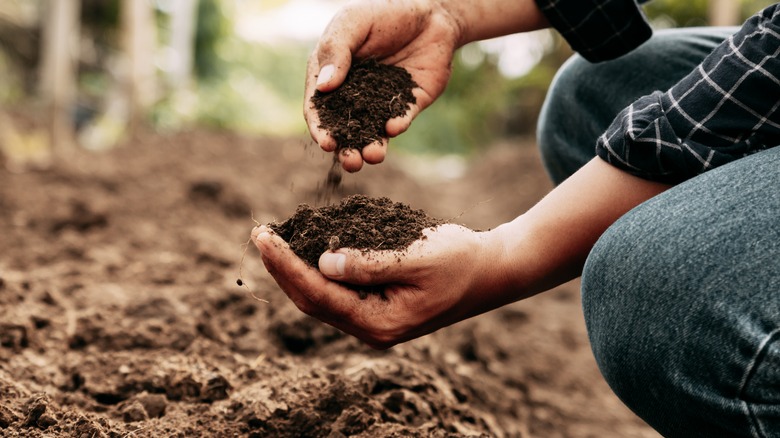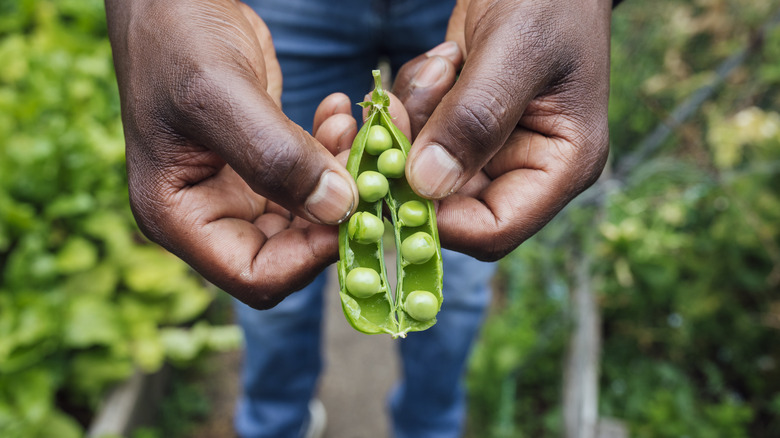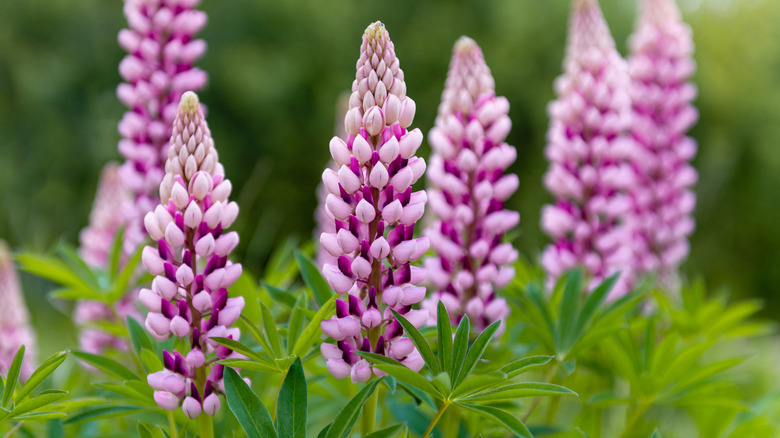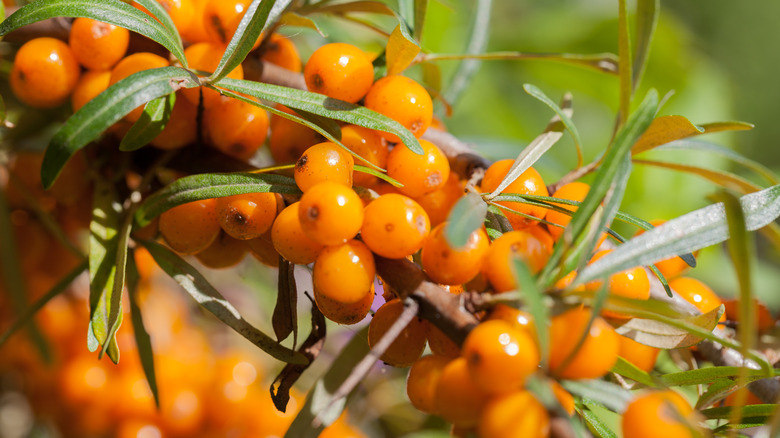Plants That Add Nitrogen To Your Garden Soil
Gardening is a great way to do something good for your health and it also feels completely rewarding when you get to see all your hard work grow into beautiful flowers or tasty vegetables. However, the problem with gardening is that certain plants (especially vegetables like tomatoes, cabbage, sweet corn, onions, and potatoes) require more nutrients than others. This means that after a few years of gardening, you may end up with soil lacking key nutrients. Nitrogen is one of the most important nutrients for garden health and if your soil doesn't have enough, your plant's leaves will turn yellow and its growth will be stunted.
To fix low-nitrogen soil, the best solution is to add nitrogen fertilizer. However, as you probably don't want to spend money on garden fertilizer every year, once you've restored the nitrogen levels of your soil using fertilizer, you can maintain those levels by rotating the plants in your garden with nitrogen fixers every few years. Nitrogen fixers are specific species of plants that contain a special bacteria that can pull nitrogen from the air down into the soil, making it bioavailable for plants. Luckily, there are plenty of easy-to-grow flowers and vegetables that add nitrogen to the soil and are perfect for backyard gardens.
Beans
Nutrient-rich beans are good for you and your garden soil. In fact, beans are some of the best nitrogen-fixers around and are the perfect answer to a vegetable garden with soil low in nitrogen. Soybeans, fava beans, and black-eyed peas are some of the beans that add the most nitrogen. Even though these beans are typically thought of as large-scale farming crops, they can be successfully grown in backyard gardens. Soybean bushes typically reach a height of three to five feet and one plant is capable of producing anywhere from 50 to 100 pods — think of all the edamame! Fava beans and black-eyed peas normally grow in large climbing plants on commercial farms but can also be found in smaller varieties that are perfect for home vegetable gardens.
Furthermore, while they may not add quite as much nitrogen to the soil, common green beans and runner beans are also nitrogen-fixers and are a good yearly addition to any garden space.
Peas
Peas, as part of the same plant family as beans (legumes), are also great nitrogen fixers. Standard green peas, snow peas, and snap peas are all great options for any vegetable garden and make for great companion plants for your other vegetables. The best thing about peas is that you can choose the variety that best suits you. Go for pole peas if you want a privacy barrier of long green vines, or, go for bush peas if you don't want to worry about supporting your plants with trellises or chicken wire.
Furthermore, if you have a flower garden, then you can consider rotating out some of your flowers with sweet peas. Sweet pea is a viny plant that belongs to the pea family but produces inedible pods along with a bunch of beautiful white, pink, or purple flowers. Sweet pea is a climbing plant that looks beautiful growing over a trellis or fence and will be completely at home in even the most manicured flower gardens.
Lupine Flowers
If you are looking for a nitrogen fixer that has that wow factor, then there is no better option than lupines. There are many varieties of lupines (including the classic Texas bluebonnet) and they come in almost every color. On top of all the color choices and combinations, what makes these flowers special is that they grow in vertical cone-shaped towers of vibrant petals. The striking form and color of these flowers make them a treat for every garden.
Lupines, depending on the variety, can be planted in growing zones four to nine and can get anywhere from one to seven feet tall. These flowers are perennial meaning that they will die in winter, but they are also self-sowing — so a new crop of cone-shaped flowers will grow in the same space each spring. There are many native varieties of lupines across the U.S. (like the coastal bush lupine of California) and it is worth looking up which species of this spectacular flower is native to your area. This way you can draw pollinators while fixing your soil's nitrogen. Lupines are the preferred food of multiple types of native bees, butterflies, and hummingbirds.
To really draw hummingbirds to your yard, make sure to choose a vibrant red flower like the Lupinus polyphyllus (also known as the tequila flame lupine).
Clover
Commonly considered a weed and treated with herbicide in residential lawns, clover is actually a vastly misunderstood plant and an excellent nitrogen-fixer. In fact, according to the University of Georgia, a field of common red and white clover can fix nitrogen levels of around 100 to 200 pounds per acre. It's for this reason that clover is commonly seen in farm pastures and homestead gardens. However, you don't have to be a large-scale farmer to access the nitrogen-fixing benefits of clover.
If you live in a warm climate without a true winter, you can use clover as a winter cover crop. This means growing the clover over your empty vegetable garden in the winter to restore the soil before spring planting. Then, around two to three weeks before you start planting your new crop of veggies, go ahead and till the clover directly into the soil to lock all the nitrogen inside and add some natural green fertilizer.
If you don't live in a climate that allows winter cover crops, you can still use clover by planting it in between the rows of your vegetables to act as a type of living mulch. Planting clover in your garden will help protect it from soil erosion and also draw beneficial pollinators.
Nitrogen-fixing shrubs and trees
If you are looking for a more long-term nitrogen-fixing solution, then you can consider adding a more permanent nitrogen fixer like a shrub or tree to your garden. One nitrogen-fixing shrub that is native to North America and can be harvested after about two to three years is licorice. The flavor of licorice candy comes from the roots of a plant — and a nitrogen-fixing one at that. If you love licorice, then you can plant a licorice shrub and enjoy its purple flowers before harvesting the plant for its aromatic roots, which are often used as holistic dietary supplements for an array of ailments.
Other beautiful nitrogen-fixing shrubs include indigo bushes, California lilac, bitterbrush, American bayberry, and sea buckthorn. For an even longer-term option, you can also choose to plant nitrogen-fixing trees which include species like alder, black locust, redbud, Kentucky coffeetree, and mesquite. Nitrogen-fixing trees are especially helpful when planted next to fruit trees.





